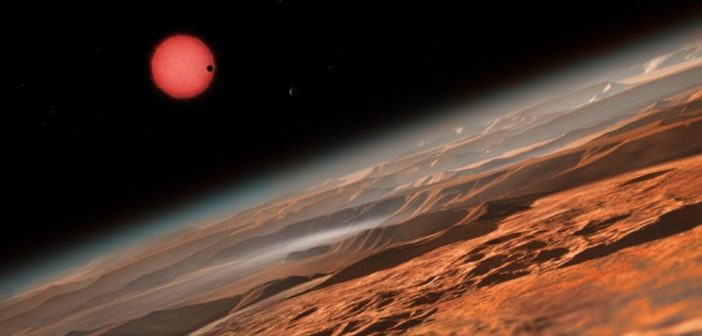The multi-planet system around the star TRAPPIST-1 is an excellent target for probing exoplanet atmospheres. A new study explores whether the skies of these exoplanets are likely cloudy or clear.
It’s All Unclear
Much like a spherical cow, a clear hydrogen atmosphere is a simple, clean, easy-to-work-with model. And much like real-life, lumpy, leggy cows, most exoplanet atmospheres are probably more complicated than the simple model. In particular, atmospheric aerosols muddy things up. These particles come in two forms: clouds, condensations of solid or liquid particles, and hazes, solid suspended particles that result from photochemical reactions in the atmosphere.Atmospheric aerosols have pesky side effects for observations — like washing out spectral features, preventing us from easily learning about an exoplanet’s composition. But they also have intriguing benefits — like protecting hypothetical life on those planets’ surfaces from the high-energy radiation of their host stars. For this reason, understanding aerosol content in exoplanetary atmospheres is an important component of learning about distant worlds.
Observing the TRAPPIST-1 Family
Unfortunately, this is also a challenging process! We learn about atmospheres through transmission spectroscopy, in which we examine spectral lines in the light that filters through a planet’s atmosphere as it transits its host. The James Webb Space Telescope (JWST) will do a better job of making observations like these once it launches — but in the meantime, we’re learning as much as we can with Hubble.
Recent Hubble observations of the TRAPPIST-1 family of exoplanets — a system of seven planets, many of which lie in their host’s habitable zone — revealed some muted spectral features from a few of their atmospheres; from these, we’ve tried to build an understanding of their properties. Now, a new study led by Sarah Moran (Johns Hopkins University) has used the latest TRAPPIST-1 mass constraints and some recent laboratory astrophysics results to update this picture.
Setting Limits
By comparing new models to the Hubble spectra for TRAPPIST-1 planets d, e, f, and g, Moran and collaborators explore the possible clouds and hazes these four planets could host. The authors vary different components of their models independently, placing limits on the planet atmospheres’ haze scattering cross sections, their metallicities, and the heights of their possible cloud decks.

Different models (colored lines) for four TRAPPIST-1 planet atmospheres, with varying metallicities and cloud-deck heights. The black data points show the Hubble observations. Click to enlarge. [Moran et al. 2018]
Future Answers
So what do Moran and collaborators find? We still don’t know exactly what the atmospheres of the TRAPPIST planets look like, but the authors’ limits suggest that planets d, e, and f could have volatile-rich atmospheres that didn’t form at the same time as the planet. For TRAPPIST-1 g, we can’t yet rule out the spherical-cow picture of a clear hydrogen-rich atmosphere.
This isn’t the end of the story though: the authors show that increased-precision observations will help break many degeneracies in their models. As soon as JWST is on the job, we can hope for more answers!
Citation
“Limits on Clouds and Hazes for the TRAPPIST-1 Planets,” Sarah E. Moran et al 2018 AJ 156 252. doi:10.3847/1538-3881/aae83a



5 Comments
Pingback: AAS Nova – New
Pingback: ¿Un día de niebla en TRAPPIST-1? – Observatori Astronòmic
Pingback: Marzo 2019 – Observatori Astronòmic
Pingback: ¿Un día de niebla en TRAPPIST-1? « SEDA / LIADA - RedLIADA - Cursos LIADA - Cielo del Mes - Fenómenos Astronómicos - RELEA
Pingback: ¿Un día de niebla en TRAPPIST-1? | Sección de Exoplanetas - Planetas extrasolares / LIADA Liga Iberoamericana de Astronomía